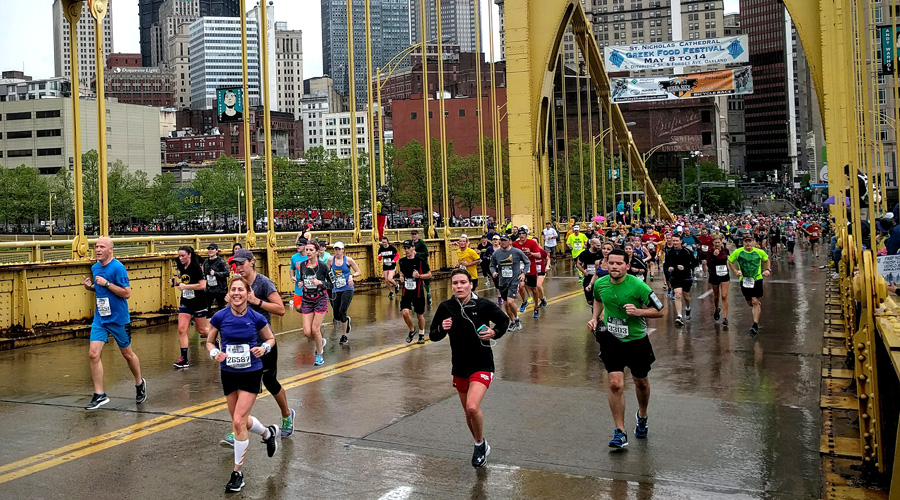The second running boom appears to be backing off as runners retreat from non-traditional races and millennials shy away from some of the longer timed ones.
After more than two decades of consistent and often double-digit increases, the number of recreational athletes completing road races declined for the second straight year in 2015, according to the latest Running USA Largest Road Races Report. The reduction was by a more significant margin than in 2014, when finisher totals edged down one percent.
Between 1990 and 2013, finisher totals skyrocketed from five million road race runners to over 19 million. For 2015, 17.1 million finishers were reported across all road race distances, a decrease of 9 percent from the previous year.
While all race distances saw fewer numbers this past year, much of the decline came from shrinking numbers in the OCR (obstacle course races) sector. Between organizations going out of business and others seeing a 30-plus-percent decrease decline in finisher totals, over one million fewer runners participated in OCR races in 2015. The category includes events with interactive components like mud or paint, fitness challenges, and other creative twists.
While the number of all races increased by 2,300 from 2014 to 2015, the number of races with 30,000 or more finishers went down from a total of nine in 2014 to six in 2015, according to the report. In addition, every race distance saw a decline of at least 3 percent, with the marathon and 5K distances down 8 percent and the 10K off percent.
Marathon finishers reached 509,000 after reaching a peak of 550,600 in 2014. A decline in marathon participants was also seen in 2012 although it was due to the cancellation of the New York City Marathon. There were 1,100 U.S. Marathon events in 2015, similar to 2014.
Half-marathon finishers declined 3 percent year-over-year, to 1.99 million. The drop came despite a record 2,700 U.S. half marathon events run in 2015, up from 2,500 in 2014.
For many in the industry, the data indicates an anticipated and healthy plateauing after years of heady growth.
“This data will not come as a surprise to many, and the sport of running, as well as the business of running, remains incredibly strong,” said Running USA CEO Rich Harshbarger, in a statement.
One concern is that participation in running events by millennials shrunk to 33 percent of all races from 35 percent the year before. While reflecting the drop off in OCR events that draw a younger crowd, millennials are also seen supporting the craze in studios specializing in cycling, CrossFit, boxing, ballet barre workouts, boot camp and weight training. Millennials are less competitive than other generations and less motivated by timed events.
Harshbarger told the Wall Street Journal that he believes higher security costs and permit fees for staging events that have driven up entry prices may be particularly affecting younger runners. He suspects they’ll come back to the sport as they “start their families and hit their professional stride in terms of earning potential.”
The Journal report also noted that according to the Sports & Fitness Industry Association (SFIA), participation by noncompetitive runners is also shrinking. Overall, the number of adults who run 50 times a year or more declined 11 percent from 2013 to 2015. In the same span, the total number of frequent runners ages 25-34 dropped 19 percent and runners ages 18-24 dropped 22 percent.
One area of continued strength, according to SFIA’s findings, is with older runners. In the last two years, the number of frequent runners age 45-64 rose slightly while the number of those 65 and older surged 25 percent.
Harshbarger said the industry is going through a natural transition period.
“For the past 25 years, road running has grown tremendously year-over-year,” Harshbarger said. “What we’re seeing is something all industries face, as eventually the momentum starts to slow down, and it’s those who adapt to consumer behaviors who continue to grow both in the short-term and long-term.”
Other findings from Running USA’s annual report:
• Females account for 9.7 million finishers nationwide and continue to represent 57 percent from event fields. Males in 2015 represented over 7 million finishers in U.S. races;
• Total number of U.S. running events reached 30,300, up 8 percent from 2014, with the largest growth seen by the 10K distance (14 percent) from an all-time high in 2013;
• The 25 to 44 year old age group is the sweet spot for running, accounting for half of finishers;
• In 2015, the 5K maintained the #1 position of all race distances with 7.6 million finishers, claiming 45 percent of all finishers in the U.S., while the half-marathon again held the #2 position with approximately 12 percent of the finishers, followed by the 10K (7 percent).
Photo by David Clucas
















